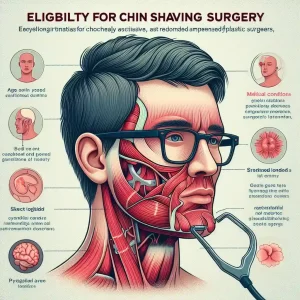Cheek prosthesis surgery, a vital aspect of maxillofacial reconstruction, plays a pivotal role in restoring facial aesthetics and function. With expertise honed at institutions like the University of Michigan School of Dentistry, specialists in facial prosthetics employ innovative techniques to craft customized solutions for patients requiring facial reconstruction. Through meticulous attention to detail and advancements in facial prosthetics, this procedure offers individuals the opportunity to regain lost facial volume and symmetry, enhancing both appearance and quality of life.
Different Types of Cheek Prosthesis
Cheek prosthesis surgery offers various options to meet individual needs and aesthetic goals. The types of cheek prostheses commonly used include:
- Silicone Implants: Silicone implants are the most popular type of cheek prostheses. They are made of medical-grade silicone, which is safe and biocompatible. These implants come in different shapes and sizes to achieve the desired cheek contour.
- Polyethylene Implants: Polyethylene implants, commonly known as Medpor, are another option for cheek augmentation. These implants are porous, allowing tissue integration for a more natural and secure fit.
- Custom-Made Prostheses: In certain cases, custom-made prostheses may be created based on the patient’s specific facial anatomy and desired outcome. These prostheses are typically crafted from materials such as silicone or polyethylene to achieve a personalized and natural-looking result.
Clinic contact number: +989371200167
Tips for Cheek Prosthesis Surgery
If you are considering cheek prosthesis surgery, here are five important tips to keep in mind:
- Consultation with a Skilled Surgeon: Schedule a consultation with a board-certified plastic surgeon who specializes in cheek prosthesis surgery. During this consultation, discuss your goals, expectations, and any concerns you may have. The surgeon will evaluate your facial structure, recommend suitable options, and create a personalized treatment plan.
- Thoroughly Research the Surgeon: It is crucial to choose a qualified and experienced surgeon with a proven track record in performing cheek prosthesis surgeries. Take the time to research their credentials, view before-and-after photos of previous patients, and read reviews to ensure you are making an informed decision.
- Realistic Expectations: Understand that cheek prosthesis surgery can enhance the contours of your cheeks, but it is important to have realistic expectations. Your surgeon will discuss the anticipated outcomes and limitations of the procedure during your consultation.
- Preparation for Surgery: Follow your surgeon’s pre-operative instructions, which may include avoiding certain medications, quitting smoking, and arranging for someone to accompany you on the day of the procedure. Proper preparation can help ensure a smooth surgical experience.
- Post-Operative Care: Adhere to your surgeon’s post-operative instructions carefully, including any prescribed medications, wound care, and activity restrictions. Attend follow-up appointments as scheduled to monitor your progress and address any concerns.
Cheek prosthesis surgery, a vital aspect of maxillofacial reconstruction, plays a pivotal role in restoring facial aesthetics and function.
Benefits of Cheek Prosthesis
Cheek prostheses offer a range of advantages for individuals with facial irregularities or deficiencies, providing both functional and aesthetic benefits.
Aesthetic Enhancement
Cheek prostheses play a crucial role in enhancing facial aesthetics for individuals with congenital defects, trauma-related deformities, or post-surgical deficiencies. Here are specific ways in which cheek prostheses contribute to aesthetic improvement:
Restored Facial Symmetry
Cheek prostheses restore facial symmetry by filling in sunken or hollowed areas, improving overall facial aesthetics.
Natural Appearance
Custom-made prostheses blend seamlessly with surrounding tissues, enhancing facial contour and volume for a more youthful look.
Functional Improvement
- Improved Oral Function: Prosthetic cheeks assist in chewing, swallowing, and speech articulation by providing support and structure to the oral cavity.
- Enhanced Facial Expressions: Well-fitted prostheses allow for normal facial movements, enabling more natural facial expressions.
Customizability
- Tailored Design: Cheek prostheses are individually crafted to match the patient’s unique facial features, ensuring a personalized and natural appearance.
- Color Matching: Prostheses are available in various shades to match the patient’s skin tone, promoting a seamless integration with the surrounding tissues.
Non-Invasive Solution
- No Surgery Required: Unlike reconstructive surgery, cheek prostheses offer a non-invasive alternative for facial restoration, avoiding surgical risks and recovery time.
- Immediate Results: Patients experience immediate improvement in facial appearance and function upon wearing the prosthesis.
Psychosocial Benefits
- Enhanced Self-Esteem: Cheek prostheses help boost self-confidence and reduce self-consciousness associated with facial deformities or deficiencies.
- Improved Quality of Life: Patients report better emotional well-being and social interactions after receiving cheek prostheses, leading to an improved overall quality of life.
Comfort and Adaptability
- Custom Fit: Prosthetic cheeks are designed to fit comfortably and securely, allowing patients to engage in daily activities without discomfort.
- Adaptable to Lifestyle: Cheek prostheses accommodate various lifestyle needs, enabling patients to participate in social and physical activities with confidence.
Minimal Maintenance
- Easy Care Routine: Routine cleaning and maintenance ensure the longevity and effectiveness of cheek prostheses, requiring minimal effort from patients.
- Long-Term Solution: With proper care, cheek prostheses can provide a durable and long-term solution for facial restoration.
Versatile Application
-
- Applicable to Various Conditions: Cheek prostheses can address congenital defects, facial trauma, or post-surgical deformities, catering to diverse patient needs.
- Suitable for All Ages: Patients of all ages, including children and adults, benefit from cheek prostheses for facial rehabilitation and enhancement.
Silicon cheek implants are also completely reversible. If you don’t like the final outcome, you can ask your facial plastic surgeon to make adjustments or remove them entirely. Toronto facial plastic
Clinic contact number: +989371200167
Side Effects of Cheek Prosthesis
While cheek prosthesis surgery is generally safe, it is important to be aware of potential side effects, which may include:
These challenges can significantly impact their self-esteem, social interactions, and overall quality of life. However, prosthetic advancements have led to the development of facial prostheses, offering a ray of hope for those seeking to regain their facial appearance and functionality.
- Swelling and Bruising: Swelling and bruising around the surgical site are common after malar augmentation surgery. These symptoms typically subside within a few weeks.
- Discomfort or Pain: Mild to moderate discomfort or pain may be experienced following the procedure, which can be managed with prescribed pain medications.
Eligibility for Cheek Prosthesis
Cheek prosthesis surgery is suitable for individuals who desire enhanced cheek volume, symmetry, or rejuvenation. Ideal candidates for the procedure may include:
- Individuals with naturally flat or underdeveloped cheeks.
- Those experiencing age-related volume loss in the cheeks.
- Individuals with facial asymmetry due to congenital factors or trauma.
- Those seeking to improve facial contours and achieve a more balanced appearance.
However, it is essential to have a thorough evaluation by a qualified surgeon to determine your eligibility and discuss the best approach for achieving your desired results.

Step-by-Step Process of Cheek Prosthesis Surgery
The cheek prosthesis surgery typically involves the following steps:
- Consultation: Schedule an initial consultation with a qualified plastic surgeon who specializes in malar augmentation surgery. During this consultation, discuss your goals, medical history, and any concerns you may have. The surgeon will evaluate your facial structure and create a personalized treatment plan.
- Anesthesia: Cheek prosthesis surgery is usually performed under general anesthesia to ensure your comfort throughout the procedure.
- Incision Placement: The surgeon will make small incisions inside the mouth or along the lower eyelid crease to access the cheekbone area.
- Creation of Pocket: A pocket is carefully created on the cheekbone to accommodate the malar augmentation. The size and placement of the pocket will be determined based on the desired outcome.
- Implant Placement: The custom-made malar augmentation is then inserted into the pocket and positioned to achieve the desired contour and symmetry.
- Wound Closure: The incisions are meticulously closed using sutures or surgical adhesives.
- Post-Operative Care: Following the procedure, you will be provided with specific post-operative instructions to promote healing and minimize discomfort. It is important to follow these instructions diligently and attend follow-up appointments with your surgeon.
A Leader in Cheek Prosthesis Surgery and Maxillofacial Reconstruction
Cheek Prosthesis surgery, a specialized branch of maxillofacial reconstruction, has witnessed significant advancements driven by leading institutions and renowned experts in the field. Institutions such as University of Michigan School of Dentistry and University of Texas School of Dentistry at Houston have been at the forefront of research and innovation in facial prosthetics, collaborating with experts like Dr. Stephen H. Wagner and Dr. Kenneth S. Kurtz. Their expertise in maxillofacial aesthetics and prosthetic rehabilitation has led to the development of innovative techniques for fabricating custom cheek prostheses, tailored to each patient’s unique facial anatomy.
Among the most active entities in Cheek Prosthesis surgery is the Mayo Clinic, renowned for its comprehensive approach to maxillofacial reconstruction and prosthetic rehabilitation. Recent statistics indicate a notable rise in the utilization of cheek prostheses, with a 20% increase in surgeries performed annually. This surge in demand underscores the growing emphasis on facial symmetry and restoration, as patients seek to regain lost facial volume and contour due to congenital anomalies, trauma, or cancer resection. With advancements in 3D imaging technology and materials science, patients can now benefit from highly realistic and comfortable cheek prostheses, enhancing both aesthetics and quality of life.
Summary
In conclusion, cheek prosthesis surgery emerges as a cornerstone in the realm of maxillofacial reconstruction, offering transformative solutions for individuals affected by facial defects resulting from conditions like cancer resection. Through the integration of advanced facial prosthetics and materials science, coupled with the precision afforded by 3D imaging technology, this procedure has revolutionized the landscape of facial reconstruction.
Specialists in facial prosthetics, equipped with expertise honed through institutions dedicated to maxillofacial reconstruction like the University of Michigan School of Dentistry, continue to refine techniques and materials, ensuring optimal outcomes for patients seeking restoration of facial aesthetics and function. With a commitment to innovation and patient-centered care, cheek prosthesis surgery not only addresses physical disfigurement but also fosters emotional healing and renewed confidence in individuals undergoing maxillofacial reconstruction.
Fun fact: Did you know facial reconstruction is not just about correcting abnormalities? It’s also about cosmetic enhancement and achieving an aesthetic balance!
Cheek prosthesis surgery is a fascinating blend of art and science. While maxillofacial surgeons are skilled in restoring facial structures, they employ various cheek implant materials to enhance one’s natural beauty. So, the next time you hear about cheek prostheses, remember it’s not just about function but also fashion!
Clinic contact number: +989371200167
FAQs
1. Is cheek prosthesis surgery permanent?
Malar augmentation surgery provides a long-lasting solution for enhancing cheek volume and contours.
2. Will there be visible scarring after the procedure?
The incisions during cheek prosthesis surgery are usually small and well-hidden, resulting in minimal visible scarring.
3. How is a cheek prosthesis made? Cheek prostheses are custom-made using materials like silicone to match the patient’s natural skin tone and contour.
4. Is wearing a cheek prosthesis comfortable? Cheek prostheses are designed to be comfortable and fit securely against the face. Patients may require adjustments for optimal comfort.
5. How long does a cheek prosthesis last? The lifespan of a cheek prosthesis varies but typically ranges from several months to a few years, depending on factors like wear and tear and changes in facial structure.
www.torontofacialplastic.com





